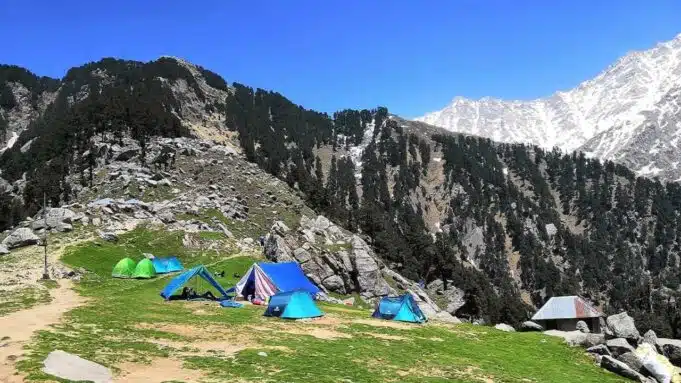The Triund Trek and Snowline Trek are two of the most popular trekking routes in the Dhauladhar range of Himachal Pradesh, known for their breathtaking views, accessibility, and moderate difficulty level. While these treks are open year-round, the experience varies greatly depending on the season. Understanding the seasonal changes and weather patterns is essential for anyone planning to undertake these treks, as it helps ensure a safe and enjoyable journey.
Spring: March to June
Spring is widely considered the best time to embark on the Triund Trek. The weather during these months is mild, with clear skies and pleasant temperatures ranging between 10°C and 25°C. This period is ideal for trekking, as the trails are dry, and the blooming rhododendrons add vibrant colours to the landscape. The lush green meadows at Triund top are a sight to behold, and the clear skies provide unobstructed views of the Kangra Valley and the majestic Dhauladhar range.
For those considering the Snowline Trek, spring offers similar advantages. As the snow begins to melt, the trail becomes more accessible, and the snowline recedes, making it easier to reach the Snowline Café.
Temperatures remain manageable, with daytime highs in the mid-teens and cooler nights that require warm clothing. The moderate conditions of spring make it an excellent time for beginners and experienced trekkers alike to explore both the Triund Trek and the Snowline Trek.
Monsoon: July to August
Monsoon season brings significant challenges to trekking in Himachal Pradesh, and the Triund Trek is no exception. From July to August, the region experiences heavy rainfall, which can make the trails slippery and prone to landslides. The consistent rain also obscures the otherwise stunning views of the surrounding mountains, making this a less favourable time for trekking.
Despite the challenges, some trekkers still choose to visit Triund during the monsoon season because of the misty atmosphere and the lush greenery that dominates the landscape. However, caution is advised, and it is important to stay informed about the weather conditions before setting out. The Snowline Trek, in particular, becomes more difficult during this period, as the higher altitude and narrow trails can become treacherous due to the rain. For safety reasons, most trekkers generally avoid this season.
Autumn: September to November
After the monsoon rains subside, autumn emerges as another prime season for trekking. From September to November, the weather is cool, with temperatures ranging between 8°C and 20°C, and the skies clear up, offering spectacular views. This is the perfect time to witness the panoramic beauty of the Dhauladhar range and the Kangra Valley without the crowds that often accompany the summer months.
Crisp air, golden-hued landscapes, and a peaceful trekking experience characterize the Triund Trek during autumn. The trail conditions are excellent, and the views from Triund top during this season are particularly stunning, especially at dawn and dusk when the light paints the mountains in shades of pink and orange. The Snowline Trek is also highly recommended during this time, as the snow has mostly melted, and the higher altitudes are accessible without the extreme cold of winter.
Autumn is an ideal time for those seeking a quieter and more contemplative trekking experience, as the post-monsoon freshness enhances the beauty of both the Triund Trek and the Snowline Trek.
Winter: December to February
Winter presents a different kind of challenge for trekkers in the Dhauladhar range. From December to February, the region is blanketed in snow, transforming the Triund Trek into a winter wonderland. While the views are undeniably breathtaking, the trek becomes more difficult due to snow-covered trails and freezing temperatures that can drop as low as -5°C. Proper gear and clothing are essential for trekking during this season.
The Snowline Trek, as the name suggests, becomes even more challenging in winter, with deep snow covering the trail. For those experienced in winter trekking and looking for a true adventure, the Snowline Trek offers a unique opportunity to experience the Himalayas in their full winter glory. However, first-time trekkers are generally advised to avoid winter treks unless they are well-prepared and accompanied by a guide.
Despite the difficulties, winter treks to Triund are still possible for those looking for solitude and the chance to witness the Dhauladhar range in its most pristine state. The snow-covered landscape, combined with the silence of the mountains, makes for a peaceful yet physically demanding trek.
Conclusion
The Triund Trek and Snowline Trek offer different experiences depending on the season, each with its own set of advantages and challenges. Spring and autumn are generally the most favourable times to visit, with mild weather, clear skies, and well-maintained trails. Monsoons bring risks due to heavy rainfall and landslides, while winter offers a more adventurous trek through snow-covered landscapes.
Understanding the seasonal changes and weather patterns is crucial for planning a trek that aligns with personal preferences and safety considerations. Whether seeking a vibrant springtime trek or a quiet winter adventure, both the Triund Trek and Snowline Trek promise stunning views and memorable experiences for all who venture into the Dhauladhar range.















